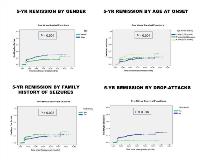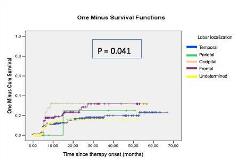Predictors of five-year remission in focal epilepsy of unknown cause
Abstract number :
2.367
Submission category :
18. Late Breakers
Year :
2010
Submission ID :
13424
Source :
www.aesnet.org
Presentation date :
12/3/2010 12:00:00 AM
Published date :
Dec 2, 2010, 06:00 AM
Authors :
E. Beghi, U. Aguglia, A. Labate, S. Gasparini, L. Mumoli, C. G. Leonardi, V. Cianci, M. A. Latella, A. Gambardella
Rationale: Focal epilepsy of unknown cause (FEUC) is a heterogeneous clinical disorder including patients with severe refractory forms and patients with a fairly good prognosis. Predictors of prognosis in FEUC are poorly understood. Methods: Two thousand and eighty-three patients with FEUC were consecutively seen from April 1987 to April 2010 in two Epilepsy Centers located in Reggio Calabria and Catanzaro, Calabria, Southern Italy. 909 patients were excluded because of insufficient anamnestic data, psychogenic seizures, major psychiatric disorders, isolated seizures, absence of neuroimaging study or presence of brain lesions except for scattered T2-hyperintense spots on hemispheric white matter. The following variables were considered : age, gender, age at onset of epilepsy, family history of epilepsy or febrile seizures (FS), perinatal factors, personal history of FS, personal history of status epilepticus, type of seizures, presumed lobar localization (frontal, temporal, parietal, occipital, undetermined), interictal EEG (normal, abnormal, unilateral, abnormal bilateral), type of recruitment (incident or prevalent case). Survival curves were generated according to the Kaplan Meier method and compared with the log-rank test. The end point was the cumulative time-dependent chance of 5-yrs remission after treatment start. Independent predictors of remission were tested by multivariate analysis using Cox proportional hazards function models.Results: The sample included 1174 patients (610 women and 564 men) aged 1 to 98 years who were followed for 1019.4 person-years. 105 cases presented 5-yr remission during follow-up. Of these, 36 were never treated. The cumulative probability of remission was 9% at 5 years, and 14, 18, and 21% at 10, 20, and 30 years. At univariate analysis, factors predicting remission included female gender, older age at onset, family history of epilepsy, drop attacks, and presumed lobar localization (fig. 1-2). Independent predictors of remission were older age at onset (Hazard Ratio, HR for each increasing year 1.001; 95% confidence interval, CI 1.000-1.002), family history of epilepsy (HR 1.6; 95% 1.1-2.4), seizures with loss of consciousness (HR 1.7; 95% CI 1.1-2.6), secondarily generalized seizures (HR 1.6; 95% CI 1.0-2.5), drop-attacks (HR 0.2; 95% CI 0.0-0.8), parietal epilepsy (HR 3.2; 95% CI 1.4-7.1), occipital epilepsy (HR 1.8; 95% CI 1.1-3.2), and being an incident case (HR 2.9; 95% CI 1.8-4.6). When limiting the analysis to incident cases, independent prognostic predictors were only loss of consciousness and occipital epilepsy. Conclusions: Up to one fifth of cases with FEUC attain 5-yr seizure remission during follow-up. Older age at onset, family history of epilepsy, seizure type, and lobar localization are independent prognostic predictors. However, only lobar localization and seizures accompanied by loss of consciousness are favorable prognostic predictors in patients seen at diagnosis.

